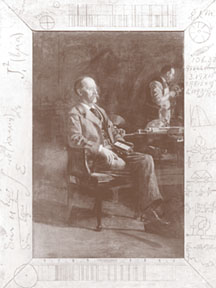 Photo courtesy of AIP Niels Bohr Library; T. Eakin's painting at Addison Gallery of Art, Phillips Academy, Andover, Massachussetts |
Henry Augustus Rowland: 1848-1901
A principal founder and first president of the American Physical Society in 1899, Henry Augustus Rowland earned the recognition of his peers as "the highest known authority" in the U.S. on the subject of the laws and principles of electricity. He was born in Honesdale, Pennsylvania in November 1848, the son of a Protestant clergyman who was the latest in a long line of theologians. Henry's great-grandfather had used his pulpit to denounce foreign oppression with such zeal that he had to flee the city during the American Revolution, when a British fleet invaded Providence. Young Henry was expected to follow suit, attending Yale University and entering the ministry, but he rebelled against family expectations. He was an avid chemical and electrical experimenter and wished to study engineering. His family ultimately relented and he enrolled at Rensselaer Polytechnic Institute in the fall of 1865.
Rowland graduated with a degree in civil engineering in 1870, and worked as a railroad surveyor and as a teacher at the College of Wooster in Ohio before returning to Rensselaer in 1872 as an instructor of physics. His first major research was an investigation of the magnetic permeability of iron, steel and nickel, work which won the praise of Maxwell and established his reputation as a promising young experimental physicist in the U.S.
In 1875, Rowland accepted a chair in physics at the newly-established Johns Hopkins University, America's first true research institution, and spent a year in Europe inspecting various laboratories and purchasing experimental equipment. As a result of his efforts, by the late 1870s, the university's facility obtained one of the finest collections of research instruments in the world at that time.
Inspired by his study of Faraday's Electrical Researches, in 1868 Rowland devised an experiment to test whether the magnetic effect produced by electric current was the direct result of charge moving through space or of some interaction between the current and the conducting body. While his results did not prove or disprove either theory, the experiment was the first to conclusively demonstrate that the motion of charged bodies produced magnetic effects. In the late 1870s, he established an authoritative figure for the absolute value of the ohm, and redetermined the mechanical equivalent of heat in the early 1880s, demonstrating that the specific heat of water varied with temperature. He also suggested and supervised the experiments which led to the discovery of the Hall effect by one of his graduate students.
However, Rowland is best known for his invention and ruling of the concave spectral grating, instead of ruling his diffraction gratings on the traditional flat surface. Since such gratings were self-focusing, lenses - which absorbed infrared and ultraviolet radiation - were no longer necessary. And the optical properties of a concave grating greatly simplified the observation of spectra. The invention reduced the work of several days to a few hours, and Rowland sold more than 100 of them at cost to physicists worldwide. Rowland himself used the device to remap the solar spectrum, and his wavelength tables were ten times more accurate than their best predecessors, becoming the accepted standard for over a generation.
Rowland received a gold medal and grand prize for his gratings at the 1890 Paris Exposition. He was a foreign member of the Royal Society of London and the French Academy of Sciences, and was elected to the National Academy of Sciences, which awarded him its Rumford and Draper medals for his research accomplishments. Other professional honors included appointment as a delegate of the U.S. government to various international congresses on the determination of electrical units. Rowland was a lifelong avid proponent of basic research, even disparaging technological invention in favor of "pure science" in a celebrated 1883 address as vice president for the American Association for the Advancement of Science. Yet even he was ultimately forced to acknowledge the economic necessity of technological innovation. He married in 1890 and was diagnosed with diabetes soon afterward. Eager to assure the future financial security of his family, he worked on the development of a multiplex telegraph, which, while technically successful, did not succeed commercially before his death in 1901. His ashes were interred in the wall of his basement laboratory in accordance with his wishes.
©1995 - 2024, AMERICAN PHYSICAL SOCIETY
APS encourages the redistribution of the materials included in this newspaper provided that attribution to the source is noted and the materials are not truncated or changed.
November 1998 (Volume 7, Number 10)
Articles in this Issue

